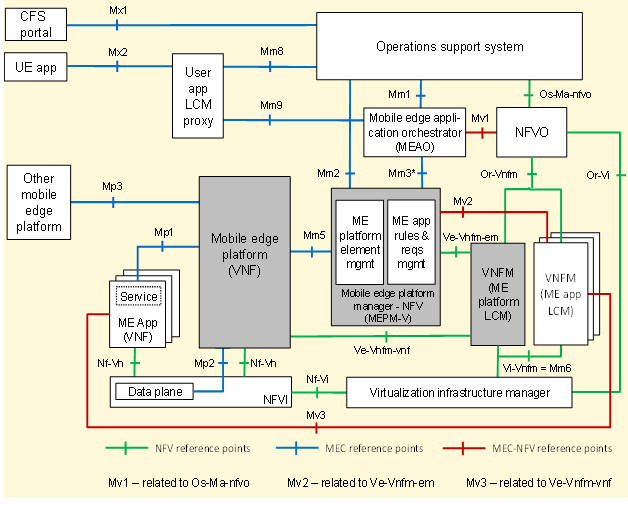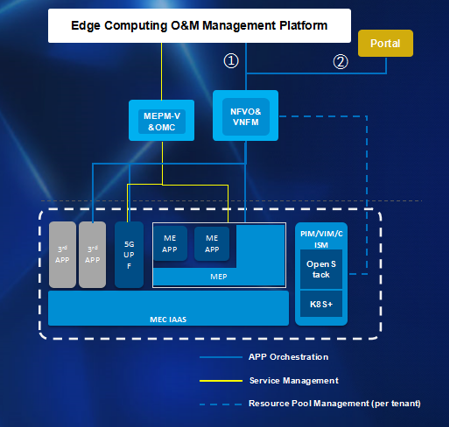With the continuous upgrade and update of 5G technologies, the application scope is also expanding. Industry applications put forward more stringent requirements for network construction, such as high bandwidth and low latency. The traditional centralized communication network is quietly evolving some computing capabilities to the edge. In this case, O&M system architectures and O&M operation scenarios are undergoing great changes. In the context of intensive O&M, how to cooperate with edge O&M becomes particularly important.
What is Edge Computing?
The word "edge" comes from the abstract concept of geographical area. Distributed computing just occurs in today's cloud technology environment. In general, "cloud computing" consists of a group of connected servers that are clustered together to avoid server-level failures. In the future, Mobile Edge Computing (MEC) is an important 5G application scenario. In the MEC field, edge nodes get closer to users, to further promote service experience indicators and improve user perception.
To ensure fast deployment and stable operation of systems including edge nodes, a complete set of automatic edge O&M systems is required to support the entire edge computing architecture.
What is Edge O&M Architecture?
As defined in ETSI protocol specifications, the edge computing network management (NM) system consists of such management nodes as NFVO, MEAO, EMS, MEPM and VNFM (including MEP LCM and APP LCM).
In addition, the NM system can be connected to the service operation system to provide capabilities such as edge service provisioning, changing, and capability exposure monitoring. It can also be connected with edge nodes to carry out deployment, life cycle management and configuration for node resources and services, and monitor assurance capabilities.

Figure 1 Standard MEC Architecture
As shown above, the O&M architecture has more management nodes than the original O&M system, which greatly increases the overall complexity and brings great challenges to the construction and routine O&M of the O&M system, including:
Challenge 1: Unified APP management. There are various types of edge APPs. Some APPs have CT features, and can provide all deployment elements of original CT application packages. Some APPs only have deployment packages and only need basic instantiation deployment, not requiring complex features. Besides, some APPs do not need the orchestrator to implement orchestration and instantiation, but only need to allocate related virtual resources. Multiple deployment modes have various requirements for the deployment of management nodes and need to be supported according to different scenarios.
Challenge 2: APP deployment forms are different, and the corresponding resource pools need to be managed in a unified way. Some VNFs use VM form, some VNFs use VM + container form, and some VNFs use bare metal + container form. The orchestration manager can completely meet the deployment and management requirements of VNFs in different deployment modes.
Challenge 3: Multi-node collaboration in the management domain. As shown in the figure, there are many MEC management nodes. How each management node cooperates with each other becomes the key problem, for example, in the process of APP deployment initiated by OSS, how to connect the APP to MEPM, how to complete the initial configuration of the APP, how to deliver rules, and how to select and restrict services required by the APP.
Edge cloud management solution:
First, we need to sort out management nodes to be contained in edge cloud management nodes:
1) MEAO invokes the NFVO/VNFM capability to implement the lifecycle management capability for such virtualized telecom NEs as UPF and MEP.
2) MEAO invokes the NFVO/VNFM capability to implement the lifecycle management capability for MEC APP, and works with the edge cloud node VIM/CISM to distribute resources for third party APPs.
3) MEAO invokes the edge cloud node EMS/MEPM to implement the service configuration capability of UPF and MEP.
4) EMS provides O&M management for UPF.
5) MEPM implements the O&M management capability for MEP, and manages rules and requirements of the APP.
6) Various O&M management tools implement monitoring, preventive maintenance, fault analysis and location capabilities for edge node resource pools.
The third party application management system is usually provided by the third party application vendor to implement the management capability of the APP service, that is, the EMS of the third party application.

Figure 2 Convergence of multiple management nodes, reducing O&M complexity
Automatic edge node management
For edge cloud nodes, the overall O&M requirements are similar to those for central cloud O&M, including planning, design, deployment, maintenance, and operation optimization. However, due to the characteristics of the edge cloud, such as flexibility, small size, and many nodes, the edge cloud must be equipped with sufficient automation capabilities to provide effective O&M suggestions for massive edge nodes.
Automatic design: By collecting network traffic model parameters, the system automatically identifies network capacity at present and within a certain period in the future. According to the resource model, the capacity is calculated as the number of resources required by the system, including the number of edge nodes. It can notify the planning and design personnel in advance of network capacity expansion or new address commissioning.
Automatic deployment: There are a large number of edge nodes. If they are deployed manually one by one, it will cause long time, prone to error, and high costs. Automatic deployment of edge nodes requires that after the core data center is deployed, edge nodes can be plug-and-play and automatically installed and deployed. Once edge devices are powered on, configuration data is automatically loaded and services are automatically activated. This achieves unmanned operations, improving deployment efficiency and reducing deployment costs.
In addition, APP deployment uses a hierarchical management system. Some APPs are deployed by using standard deployment packages to enhance deployment requirements and provide complete lifecycle capabilities. Some APPs can use a simplified deployment solution to reduce deployment costs and improve deployment efficiency. Different modes can be used for different scenarios and requirements.
Automatic O&M: To efficiently manage edge nodes and reduce O&M complexity and costs, the edge computing O&M management system must have intelligent closed-loop assurance capabilities such as network self-perception and self-adjustment. The most urgent problem to be solved is to rapidly delimit and locate problems by using intelligent algorithms, to find the root cause, so that the problem can be solved more efficiently.
At the same time, the network policy is still based on the manual static configuration, ignoring the actual network conditions. After AI is introduced, the system can intelligently analyze and judge the traffic, congestion level, and load status based on time, location, and mobility. The AI training platform outputs dynamic policies to implement intelligent scheduling.
Automatic operation optimization: Real-time or history intelligent analysis can provide reference data such as health score, exception detection and prediction, and fault root cause analysis. Thereby, the system carries out configuration optimization, resource scale-in/out, and problem locating to achieve closed-loop optimization of edge O&M.
Conclusion
The complete edge O&M solution integrates core data center O&M and edge node O&M in a systematic way, so that edge nodes can play a larger role in providing services at edge positions. In a 5G network, edge computing nodes will bring users excellent user experience. The O&M system will fully transform the traditional static and manual passive O&M mode into the dynamic and automatic active predictive O&M mode, to provide intelligent capabilities that a 5G network should have.
ZTE supports AI with full-stack IT offering
5GC Green Engine Solution to Enable Green Internet of Everything in the Dual-Carbon Era
5GC Private Network 2.0 Empowerment and Efficiency Improvement Boosts High-Quality Development of the Industry
5G Empowers Intelligent Mining for High-quality Development of Shaanxi Coal Caojiatan Mining
ZTE and China Mobile embrace digitalization for biodiversity conservation in Panda Reserve
Three Aspects Contribute to ZTE’s Remarkable Breakthroughs in Advanced G4X Server
How 5G Private Networks Are Poised to Transform Enterprises Worldwide: All Scenario Private 5G Helps Operators to Realize Private 5G as a Service
ZTE’s commitment to servers generates robust growth of up to 60 times in past 8 years
ZTE eyes top 5 global server market share
Full-Scenario One-Stop 5G Private Network for Vertical Industries

